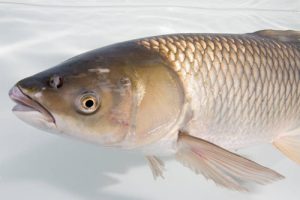From March to May 2024, scientists from the USGS will install baiting platforms for invasive grass carp and equipment for monitoring fish movement in pool 19 of the Upper Mississippi River.
Pool 19 contains 30,466 acres of aquatic habitat, extending 46.3 miles from Lock & Dam 19 located near Keokuk, Iowa upstream to Lock & Dam 18 located near Burlington, Iowa.
The bait, which has been previously tested in laboratory and field trials, are made from rapeseed, the raw material used to prepare canola oil. Bait will be distributed from autonomous, floating bait delivery stations.
Acoustic telemetry arrays, which can detect fish movement using sound waves, will be installed around each bait station.
In coordination with the Illinois Natural History Survey and commercial fishing crews, roughly 100 grass carp will be captured from pool 19, implanted with acoustic transmitters, and released. Fish movement around baiting platforms will be monitored using these tagged fish, environmental DNA, and fishing captures.
Invasive grass carp are a nuisance species found throughout much of the United States. Grass carp are opportunistic, herbivorous fish that graze on aquatic plants. While these fish were once stocked as biological controls for aquatic vegetation, overgrazing by grass carp is now damaging and even eradicating aquatic vegetation communities that are vital to many native fish species.
Loss of aquatic vegetation can also disrupt food webs for waterfowl, increase shoreline erosion, and intensify harmful algal blooms. Reducing or eliminating grass carp populations has now become a high priority among many management agencies.
Precautionary measures are in place to ensure project success and public safety. Public assistance to report unexpected events, damaged property, or suspicious activity around baiting platforms is greatly appreciated.
Boaters that notice anything out of place, signs of tampering, or displacement of any baiting platform, are asked to contact the USGS. Local, state, and federal officials have been informed of platform placement and consulted on safety measures and visibility requirements.
Hunting, fishing, and recreational activities are not restricted near platforms, but the public should not moor to or stand on platforms.
Project completion is expected by December 2024, with results being publicly available in 2025. This project is supported through the U.S. Geological Survey Ecosystems Mission Area, Biological Threats Research Program, and the Great Lakes Restoration Initiative.
source: U.S. Geological Survey
